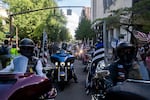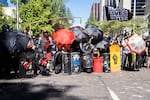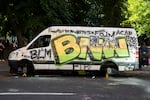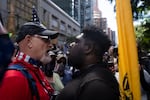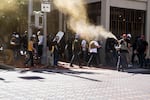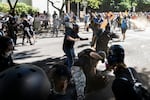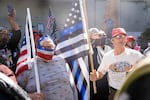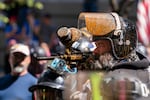In late July, Mayor Ted Wheeler had an idea he hoped would end the nightly clashes between protesters and police in Portland.
He texted Sonia Schmanski, a top aide, that he had a plan that was “high risk,” but he added that the city had “nothing to lose.”
His idea: Tell his police force to stand down from the demonstrations.
It was a move protesters had urged for months, arguing that police decked in riot gear needlessly raised the tensions of the nightly protests. Wheeler told OPB he, too, had noticed a “calming deescalating effect” on nights when police stayed out of sight.
But the protests soon drifted to the east side of the city. And Wheeler said he was persuaded that the plan was too dicey as protesters began targeting police buildings near homes in residential neighborhoods.
“I was persuaded that a complete withdrawal, even for one evening to test the ability to completely deescalate the situation, would be a risk that was too great,” he said in an interview last week. “We could not risk the people who were in the immediate vicinity.”

On Day 79 of protests against systemic racism and police violence demonstrators went to Penumbra Kelly building in East Portland.
Jonathan Levinson / Jonathan Levinson
The Hail Mary was never put to the test. And so, as the city heads toward month four of nightly demonstrations for racial justice, Wheeler seems to find himself very near where he was during month one: without a clear plan to end the now-regular clashes between the police force he oversees and the protesters whose cause he says he embraces.
“We’re all considering all options,” he said. “The core objective here is to create a free and safe space to those people who want to express their First Amendment rights and to compartmentalize and deescalate the violence as much as possible and where it’s safe to do so arrest people and hold them accountable.”
“That’s the formula.”
The issue
How to translate these principles into on-the-ground tactics has flummoxed city leaders.
The worst nights follow the same script: A large group takes to the streets calling for an end to police violence and systemic racism. A small fraction commits low-level crimes — often lighting small fires, graffiti-ing buildings and throwing fireworks or water bottles at officers. The police respond with force against the entire crowd.
Over the last month, demonstrators have been battered with batons as they left protests. Police have charged at crowds until they’re pushed deep into residential neighborhoods. Journalists have been shoved and arrested. Tear gas, while used more sparingly than in the early days of the protests, is threatened near nightly. And police regularly shut down protests by declaring them riots. That happened twice over the weekend, though police declined to intervene as far-right activists, some brandishing firearms, brawled with counter-protesters for hours on Saturday afternoon.
Police say it’s not clear how they’re supposed to address individual crimes in the midst of a sprawling crowd. Asking police to make targeted arrests in a swarm of hundreds of people could put both officers and peaceful protesters in danger. Officers worry that not going in at all would be an abdication of their duties.
The mayor recognizes the problem with these scenes that play out on the streets of his city every night: non-violent protesters facing force as police respond to the misbehavior of a few. He just hasn’t found the answer.
“This is the issue, right? I mean, this is the main question,” Wheeler said. “...How do you hold that small number of people accountable without infringing on the First Amendment rights of everyone else?”
Under Portland’s unique form of government, individual City Council members oversee day-to-day management of a portfolio of city agencies. The mayor doles out those assignments, and Wheeler, like most of his predecessors, assigned the police bureau to himself.
As police commissioner, Wheeler helps shape the bureau’s strategy for protest response. But he says he refrains from adding his voice into the fray of nightly orders that carry it out — though he’s keeping close tabs. He regularly keeps a police-issued radio turned on in his Pearl District condo. When protests wind down, he gets an emailed report from the police command center, with bullet points outlining key decisions made that night. Robert King, his public safety advisor and former head of the police union that represents officers, will weigh in with additional information.
Wheeler says he’ll sometimes follow up, such as getting clarification on why an unlawful assembly or riot was declared or a specific tactic was used. But mostly, he’s leaving nightly tactical decisions and techniques up to the police.
“They’ve tried everything from not showing up to preemptively dispersing crowds, and some of those strategies, in my opinion, have worked well. Others have not worked well,” he said. “My expectation is the police bureau will evolve, and as they see a need for change, they’ll change.”
Not all in City Hall are convinced. Commissioner Jo Ann Hardesty has framed Wheeler’s approach as more than hands-off; she says it exhibits a lack of control. In July, after a night that saw Portland police work alongside federal officers in aggressively dispersing crowds downtown, she asked the mayor to put her in charge of the police bureau. Last Wednesday — after weeks that saw the violence grow more volatile with pipebombs, gunfire and an assault — she re-upped the ask.
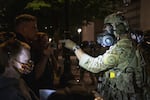
Protesters demonstrate against racism and police violence in front of the Mark O. Hatfield federal courthouse. Earlier in the night, federal law enforcement officers shot a demonstrator in the head with a less-lethal impact munition, causing severe injury.
Jonathan Levinson / OPB
Hardesty, a longtime proponent of more civilian oversight of the police, said she’d take a different tack with the nightly demonstrations: she wants to see officers stop wearing riot gear at protests, bar the use of rubber bullets and give the power to declare an unlawful assembly solely to the police chief or mayor.
Wheeler has chosen to hold onto the bureau, leaving him consistently jeered by the crowds who draw a straight line between the police tactics they see each night and the police bureau’s boss.
Public perception
From the outset of protests, Wheeler was, in the eyes of some, ill-equipped to steer the city through a revolution: a wealthy white man leading an overwhelmingly white city and a police force with a long legacy of mistrust within communities of color.
The months of protest response have not helped. After the Portland Police blanketed the streets downtown with CS gas at the onset of the protests, demonstrators crowned the mayor “Tear Gas Teddy.” In early June, he banned the long-range acoustical device, known as LRAD, and restricted the use of the gas to instances when “life safety” is threatened, a determination he says is made by the incident commander. Wheeler has apologized for the use at the beginning of the protests, but the nickname has stuck.
When the spotlight fell on Portland in July, national media outlets saw in Wheeler a mayor easily cast as a symbol of the resistance to the Trump administration; he decried the excessive tactics used by federal officers on cable news and took not one but two bouts of federal gas to the face. But protesters in the mayor’s city have held him responsible for the tear gas they tasted in June before the federal officers arrived and the tactics that returned in August when the federal officers largely stayed out of sight.
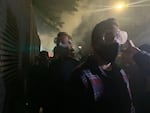
Mayor Ted Wheeler, center, stands at the fence outside the Mark O. Hatfield federal courthouse in Portland, Ore., as federal officers deploy tear gas July 23, 2020. People protesting police violence and systemic racism have been subject to tear gas, impact munitions and other dispersal tactics by PPB and federal law enforcement for nearly two months.
Rebecca Ellis / OPB
“Him and the police have made us unsafe,” said activist Demetria Hester, a leader of Moms United for Black Lives. “They charge at us like we’re cattle.”
Hester, a familiar face at the nightly protests, was arrested earlier this month soon after arriving at a protest outside the police union. Protesters had set a fire in Portland Police Association headquarters the night before, and police appeared eager to shut that evening’s protest down early. Hester was one of 16 booked.
Asked if she felt peaceful protesters had been protected, Hester laughed and asked: “By who?”
Hester said she felt the mayor could have long ago addressed the clashes by either telling his police force to stand down or by addressing the demands of the masses on the street each night head-on. Protesters had largely united around a call last month to cut $50 million from the police bureau’s budget. The city council cut $15 million. The mayor’s office says the city’s racial justice work has continued post-budget vote as staff carries out his 19-point “police reform action plan.”
Wheeler says his inbox is full of people who, like Hester, believe police are trampling on protesters’ First Amendment rights nightly. Then there’s another faction that wants to know why he has tied the hands of the police bureau. Every morning, he wakes up to a fresh batch of competing complaints.
The mayor’s inbox, at least on a Sunday in late July for which OPB sent an unrelated records request, confirms the mayor is being criticized for failed leadership from all sides.
Of the more than 90 emails related to the late-night protests, about one-fifth of senders that day seemed to feel he was abdicating his duty to protect property and police. A retired PPB detective, for example, wrote that she held the mayor “solely responsible” for injuries sustained by her former colleagues and “the wanton destruction of a once beautiful city.”
The rest came from people who wrote that they were astounded by the mayor’s failure to protect protesters and reporters from local and, at that point, federal law enforcement. One journalist’s mother wrote that she felt her son would be safer “embedded with our troops on foreign soil.”
There is a fine art to policing a protest in a way that keeps protesters safe and protects their free-speech rights without placing police in danger. Edward Maguire, a professor of criminology at Arizona State University, lays out two buckets of protest response in a guidebook he co-authored. There are differentiated responses, which focus on those engaged “in serious unlawful behavior” with “laser-like precision,” and undifferentiated responses, which treat “moderate members of a crowd as criminal or dangerous.” This latter bucket, he says, is “virtually always a bad idea,” ultimately harming police and protesters and leaving the city on the hook for costly civil rights lawsuits.
Not being on the ground, he says he can’t be clear what’s happening in Portland. But he feels secure saying that whatever city leaders are doing is not working.
“Something new is needed. I don’t even think that’s a criticism so much. It’s just obvious, right?” he said. “Something needs to happen to interrupt that back and forth escalation or else there’s just no end in sight. And eventually, somebody’s going to get really hurt and killed.”
Public comments
Nearly every night, new instances of police force are captured on camera and start making the rounds on social media sites. Nearly every morning, Wheeler is asked to condemn them.
He rarely does. He has yet to weigh in on this weekend’s police response in either the right-wing rally or the racial justice protests.
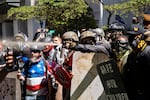
Pro- Trump and pro-police demonstrators clashed with anti-fascist counterprotesters on the 87th day of protests against police violence and systemic racism. Despite violence in the streets, police were notably absent and never declared an unlawful assembly.
/ OPB
He’s talked in the past about how he’s in a tricky spot, needing to protect the integrity of sometimes time-consuming investigations into police use of force while the public clamors for him to denounce police conduct the next day. Shown some footage by OPB, Wheeler said a 16-second clip doesn’t provide much context. But if discipline against an officer is warranted in a situation caught on camera, he says that’s what will happen.
“I am at the end of the disciplinary process, and if discipline is necessary, I mete it out,” he said. “And I have previously — all the way from minor reprimands and letters, all the way to termination. And my guess is that these incidents that have been caught on video are going to be reviewed by the independent police review commission.”
There are serious questions, however, over whether the city’s police oversight agency, which many including the mayor have called toothless, will be able to sort through the mounting reports of police violence. The office has been flooded by complaints since protests began. The director says they’ve received more than a year’s worth of new work.
Meanwhile, Hardesty has proposed an entirely new accountability system, which voters will weigh in on in November. If passed, the ballot measure would scrap the review agency completely and create a system with more independence and new powers.
It’s also not clear how the bureau is tracking police use of force at protests. The agency’s quarterly accounting of use of force incidents did not include any data from June protests due to the “ongoing nature and complexity” of the demonstrations. The report said the information will be released at a later date, but have not yet responded to an inquiry of when that date will be.
While the mayor has not condemned specific instances of police violence, he did say he believes his police force’s treatment of the media has not always been up to par. A federal judge agreed and issued a restraining order against the Portland police, citing “serious questions” regarding the tactics directed toward both journalists and legal observers.
“There have definitely been cases documented on video, where in my opinion, watching those videos, members of the media have not been treated respectfully or with the professionalism that I would expect,” he said. “I realize, on the other hand, that that creates real problems for the police from an operational perspective, understanding who is in the media, who isn’t in the media.”
The mayor has saved his harsher public rebukes for specific late-night protests where police felt protesters were intent on destruction. He described the night of June 25, for example, as “plainly and simply about arson.” The night of August 5 was “not advocacy to reform or transform any system.”
On both evenings, the storyline coming from city leadership felt starkly different than the narrative from the ground:
On the night in June, the mayor and police chief said protesters had nailed police precinct doors closed while other protesters tried to set the building on fire. Accounts on the ground showed protesters starting and then extinguishing a fire outside a beauty supply store in the same building as the precinct.
On the night in August, the city said protesters who lit a fire outside the east precinct had intended to kill someone. Videos from the night showed protesters setting a fire in a garbage can outside and using a hammer to try to break the doors of the police precinct.
John Noakes, a professor of criminology at Arcadia University, said these dueling narratives are to be expected from a city in the midst of a marathon stretch of protesting.
“This is an incredibly common practice,” Noakes said. “What I try to teach my students is not to think of it as one side lying. It’s that all the facts are true. Each side takes certain facts and highlights them and tries to generalize them.”
Noakes noted that President Donald Trump frequently uses that technique. Trump has regularly vilified Portland’s protesters this summer, pointing to instances of arson and property damage as a sign the city has been overrun by anarchists.
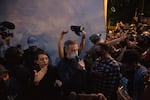
A demonstrator holds a police hat above Mayor Ted Wheeler's head at a protest against police brutality and systemic racism in Portland, Ore., July 22, 2020. Wheeler has faced criticism for the Portland Police Bureau's use of force against demonstrators long before federal officers' arrival.
Bradley W. Parks / OPB
In an August press conference that some saw as similarly vilifying protesters, Wheeler said footage of the demonstrations could provide the b-roll to Trump’s re-election campaign. Those comments drew sharp rebuke from Black Lives Matter organizers visiting Portland a few days later, who said they felt protesters’ focus remained trained on the push for racial justice. They said they’d never seen a city with so many Black Lives Matter signs in the windows.
“I frankly don’t think the mayor understands what’s happening on the ground,” said Sandy Hudson, a Black Lives Matter organizer based in Toronto who visited Portland earlier this month. “The protesters are not chanting anything else.”
The mayor had said he is hearing the push for racial justice and equity loud and clear. And he suspects he will continue to hear it for quite some time. Many believe month three of protests marks but a midway point to the November election, when both the president and the mayor are up for reelection. Both his runoff opponent Sarah Iannarone and longtime activist Teressa Raiford, who has launched a write-in campaign, have been extremely critical of his handling of the protests.
“I want to remind people when they say, ‘when is this all going to end?’ the nonviolent part of this probably won’t end for quite some time,” Wheeler said. “And I’m reminded regularly by people in this community who were engaged in the struggle for civil rights: The civil rights movement lasted a lot longer than two and a half months.”
And as for the nightly violence that accompanies it?
“I believe this will ultimately burn itself out,” the mayor said.
He says he’s working on a plan to speed that along.

